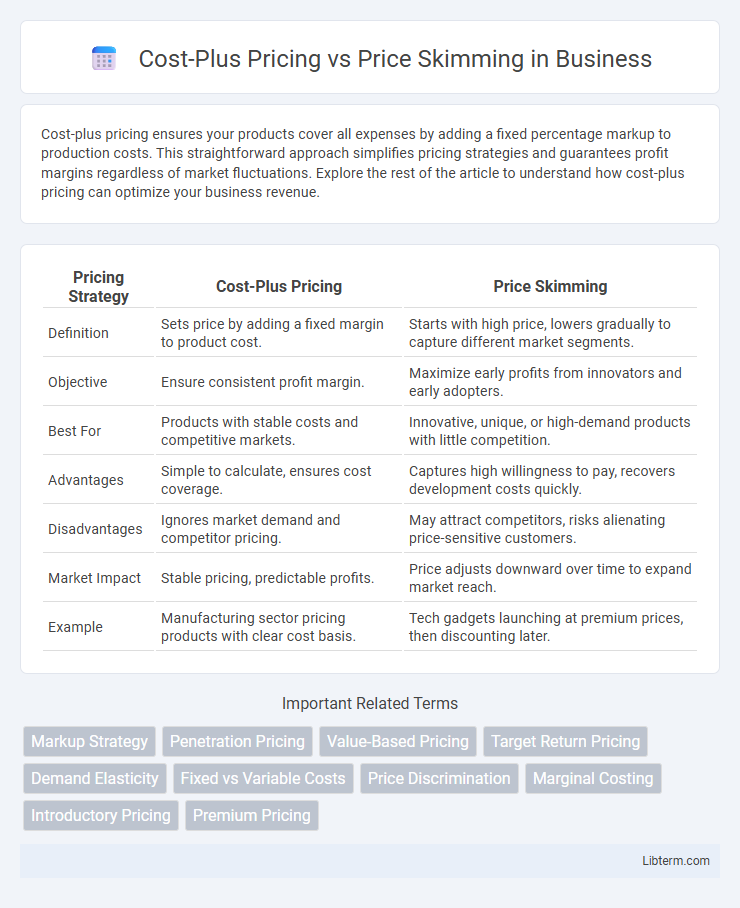Cost-plus pricing ensures your products cover all expenses by adding a fixed percentage markup to production costs. This straightforward approach simplifies pricing strategies and guarantees profit margins regardless of market fluctuations. Explore the rest of the article to understand how cost-plus pricing can optimize your business revenue.
Table of Comparison
| Pricing Strategy | Cost-Plus Pricing | Price Skimming |
|---|---|---|
| Definition | Sets price by adding a fixed margin to product cost. | Starts with high price, lowers gradually to capture different market segments. |
| Objective | Ensure consistent profit margin. | Maximize early profits from innovators and early adopters. |
| Best For | Products with stable costs and competitive markets. | Innovative, unique, or high-demand products with little competition. |
| Advantages | Simple to calculate, ensures cost coverage. | Captures high willingness to pay, recovers development costs quickly. |
| Disadvantages | Ignores market demand and competitor pricing. | May attract competitors, risks alienating price-sensitive customers. |
| Market Impact | Stable pricing, predictable profits. | Price adjusts downward over time to expand market reach. |
| Example | Manufacturing sector pricing products with clear cost basis. | Tech gadgets launching at premium prices, then discounting later. |
Introduction to Pricing Strategies
Cost-Plus Pricing involves setting prices by adding a fixed percentage or amount to the production cost, ensuring consistent profit margins and simplicity in pricing decisions. Price Skimming sets a high initial price for a new or innovative product to maximize revenue from early adopters before gradually lowering the price to attract broader market segments. Both strategies serve distinct business goals, with Cost-Plus focusing on cost recovery and stable profits, while Price Skimming emphasizes capitalizing on market demand and product lifecycle stages.
What is Cost-Plus Pricing?
Cost-Plus Pricing is a pricing strategy where a fixed percentage or amount is added to the total cost of producing a product to determine its selling price, ensuring all expenses are covered while generating profit. This method simplifies pricing decisions by focusing on costs such as materials, labor, and overhead, plus a predetermined markup. It contrasts with Price Skimming, which involves setting high initial prices to maximize profits from early adopters before gradually lowering prices.
Defining Price Skimming
Price skimming is a pricing strategy where a company sets a high initial price for a new or innovative product to maximize profits from early adopters before gradually lowering the price to attract more price-sensitive customers. This approach contrasts with cost-plus pricing, which bases the price on production costs plus a fixed profit margin, often resulting in more stable pricing but less flexibility for market penetration. Price skimming leverages market segments willing to pay a premium, enabling rapid recovery of development costs and testing price elasticity.
Key Differences Between Cost-Plus Pricing and Price Skimming
Cost-Plus Pricing determines product prices by adding a fixed percentage markup to the total production cost, ensuring consistent profit margins regardless of market demand. Price Skimming involves setting a high initial price to maximize revenue from early adopters before gradually lowering the price to attract more price-sensitive customers. Key differences include the pricing strategy basis--cost in Cost-Plus Pricing versus market demand in Price Skimming--and their objectives, with Cost-Plus focusing on cost recovery and steady profit, while Price Skimming aims at maximizing revenue during the product lifecycle's early stages.
Advantages of Cost-Plus Pricing
Cost-Plus Pricing ensures predictable profit margins by adding a fixed percentage or amount over production costs, simplifying pricing decisions and enhancing financial stability. This method provides transparency for both manufacturers and customers, fostering trust through clear cost breakdowns. It also facilitates easier budgeting and cost recovery, particularly beneficial in industries with fluctuating material costs or complex supply chains.
Benefits of Price Skimming
Price skimming allows companies to maximize revenue by targeting early adopters willing to pay premium prices, optimizing profit margins before competitors enter the market. This strategy helps recover research and development costs quickly, providing capital for innovation and marketing efforts. Firms using price skimming also reinforce a high-quality brand perception, appealing to status-conscious consumers and enabling future price adjustments as market demand evolves.
Drawbacks of Cost-Plus Pricing
Cost-Plus Pricing often overlooks market demand and competitor pricing, leading to potential overpricing or underpricing of products. This method can result in reduced profitability if cost estimates are inaccurate or if it fails to reflect customer perceived value. Businesses may lose competitive advantage as it ignores external market factors and consumer willingness to pay.
Limitations of Price Skimming
Price skimming faces limitations such as attracting competitors due to high initial prices and restricting market penetration by alienating price-sensitive customers. It can lead to rapid price erosion once competitors enter, reducing profit margins over time. This strategy may also damage long-term customer loyalty if buyers feel exploited by inflated early pricing.
When to Use Each Pricing Strategy
Cost-plus pricing is ideal for businesses with stable production costs and less price-sensitive markets, ensuring predictable profit margins by adding a fixed markup over costs. Price skimming suits innovative products or services in high-demand markets, allowing companies to maximize revenue by initially charging higher prices and gradually lowering them as competition intensifies. Choose cost-plus pricing for simplicity and consistency, and price skimming when launching new technologies or exclusive offerings to capture maximum consumer surplus.
Conclusion: Choosing the Right Approach
Choosing between Cost-Plus Pricing and Price Skimming depends on market conditions, product lifecycle, and competitive landscape. Cost-Plus Pricing ensures stable profit margins by adding a fixed markup to production costs, ideal for products with predictable expenses. Price Skimming maximizes initial revenue by setting high prices for innovative or in-demand products before gradually lowering them to attract broader customer segments.
Cost-Plus Pricing Infographic

 libterm.com
libterm.com